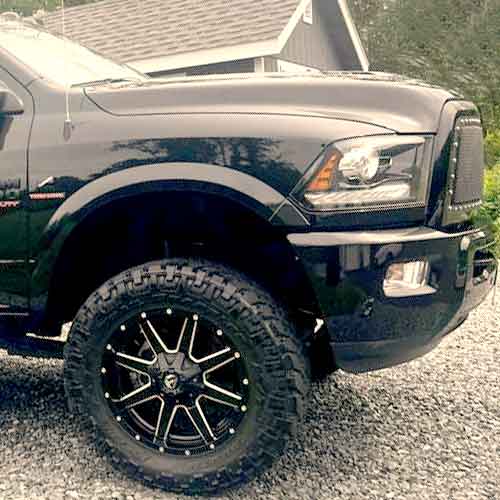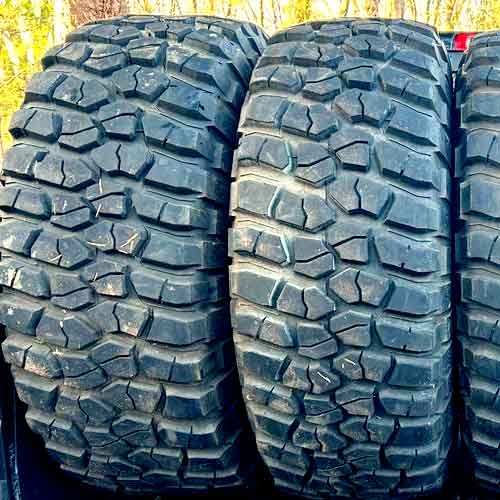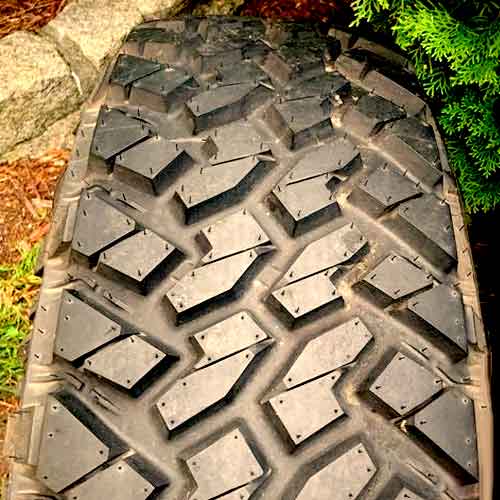The BF Goodrich KM3 and Nitto Trail Grappler M/T are favored by off-road enthusiasts for their capabilities on rough terrain and reliable traction. It’s worth noting, however, that these tires may not be the best choice for use on paved roads due to the potential for increased noise and a less smooth ride compared to other tire types.

Being a tire engineer, from my perspective, the Nitto Trail Grappler provides better directional grip on dry, great hydroplaning resistance on wet, and off road its shines in nearly all types of terrains, well except for sand. That’s because BF Goodrich KM3 is simply amazing on that terrain with its elongated shoulders. And they also help the tire on snow and in wet conditions as well. Moreover, you also see better fuel economy on it as well, though tread wear is faster in comparison.
Table of Contents
Durability
Both tires offer 3 ply polyester cover with 2 steel belts the however, the BF Goodrich KM3 only yields a single cap ply on top, whereas Nitto Trail Grappler gives you with 2.
So that makes the Nitto’s boy stronger.
Though it also increases its weight a lot, and that limits other things as you’ll see in the upcoming sections.
Available Sizes
Starting with BF Goodrich KM3 56 sizes from 14 to 22 inches.
- With speed ratings of Q.
- Load Ratings of C, D, E, or F.
- Weight Range: 37 to 83 lbs.
- They have tread depth of 18/32″.
On the other hand, Nitto Trail Grappler comes with 53 total sizes in 15 to 26 inches.
- Speed Ratings: P or Q.
- Load Range: C up to F
- Weight Range: 61 and goes up to a whopping 116 pounds.
- Tread depth: 19/32″ to 21/32″.
So looking at both tires it can be seen that they both have similar speed and load ratings, though Nitto Trail Grappler offers more tread depth, and BFG KM3 is lighter in weight.
Tread Differences
The BF Goodrich KM3 is a highly regarded tire for off roading, and that’s because of it’s unique tread features.

It presents 3 main ribs, where the outer two consist of shoulder lugs, and inner feature central blocks.
Though the whole pattern looks like its made out of shoulder lugs, that’s why you picture wider “slanted” lateral channels compared to narrower longitudinal grooves (see how central blocks look like they are part of shoulders).
The central lugs are smaller and have thick siping in them. While the shoulder lugs are elongated, and although they don’t carry (a lot) tread features, expect for minimal notches (on every other block), they create very aggressive sides.
That’s because, on the outer edges, these lugs are staggered, and they join together with each other forming sharp biters on sidewalls.
And these biters give a real treat when you run the tire with lowered air pressure, as they offer amazing chewing capabilities.
Moving on to it’s competitor, the Nitto Trail Grappler offers a similar tread structure.

It’s tread also consists of 3 ribs, where the two central ones contain hook shaped lugs.
Together they make 3 longitudinal grooves joining wider shoulder voids, with stone ejectors embedded in them.
The middle L shaped lugs have full depth siping which split them in to two, and each of those make chamfered edges.
Whereas the outer shoulder lugs are equipped with thicker slits forming in-groove notches.
And although on the outer margins, the tire makes similar staggered design as the BFG KM3, it makes dual sidewall lugs, with thicker lugs on it’s more aggressive side.
So with that, you can have a more biting abilities with lowered air pressure PSI, especially on rocky terrains, where a large footprint is highly needed.
- Detailed Review: BF Goodrich KM3
- Detailed Review: Nitto Trail Grappler
Fuel and Tread Consumption
Both fuel and tread usage depends on rolling resistance values, so it’s not surprise to see that Nitto Trail Grappler being 33 pounds heavier consumes more energy, comparatively.
Though that still does not mean, it wear off faster to as most people think.
As in case of wear, there are two other factors contributing as well, tread’s composition, and depth. And Nitto Trail Grappler offers a stiffer rubber composition and tread depth reaching up to 21/32″, whereas BF Goodrich KM3 gives you up to 18/32″ only.
So it still takes more time to burn off.
Noise
With such wild gaps between the lugs on mud tires, air can move everywhere and hit around, and this is what creates noise.
That’s why MT tires are so notorious for being “loud”.
Though still out of these tires, the Nitto Trail Grappler is quieter. This is because most of the noise/air comes through shoulders, and on BFG KM3 there is a very straight forward path for air to come in (it’s lateral grooves are wider compared to longitudinal).
Moreover, the Nitto Trail features a tread composition which produces less groove resonance as well (meaning, less noise particles bounces back off the grooves, and generates echo).
For Your Info: Best tire for tread noise in M/Ts is Falken Wildpeak M/T (review).
Rugged Terrain Perfromance
Off-road tires should be tough and able to shake off debris to handle a variety of terrain types. Let’s me discuss all these terrains one after another.
Muddy Tracks
On mud you need self cleaning grooves, plain and simple, that’s why when mud gets stuck in the tread, it’s contact with the muddy surface is just slippery (mud to mud contact generates no friction in other words).
But being “mud-terrain” tires, it’s not an issue for both of our boys here. Though you still get a little bit of better mud cleaning on the BF Goodrich KM3, due to it’s elongated shoulder lugs.
But it does not mean it takes the lead here, as Nitto Trial Grappler offers stronger sidewall lugs and mud scoops, and they create equally as good of a forward moving inertia, by throwing mud backwards and pulling itself ahead.
Rocky Trails
On rocks, you need a powerful tire (durable construction), and a tread with numerous biters, particularly on the sides/shoulders/sidewalls.
In case of durability both tires are up to mark providing 3 ply sides, with high turn up, but still since you get to have a thicker rubber layer on top of Nitto Trial Grappler, this tire still yields better overall protection.
Moreover, it’s dual sidewall design is better optimized for lateral gripping, and despite it’s heavier weight it produces superior results.
On the other side, the BFG KM3 mimics paddle tires a lot, and with lighter weight they are able to climb rocks in a better way comparatively (they have better directional traction on rocks, in other words).
For Your Info: Best tire for rocks in mud-terrain category is Cooper STT Pro (review).
Sand
Sand is pretty challenging, especially when it comes to mud tires, that’s because on this terrain, digging is your worst enemy, and mud-terrain tires are not “light” in weight at all.
But still out of both tires, the BF Goodrich KM3 still gets to dig less as it only weighs up to 83 lbs, whereas Nitto Trail Grappler, 116 lbs.
Moreover, although Nitto Trial provide thicker sidewall lugs of dual pattern, the BFG KM3 offers a surface area of pasted lugs, so with lowered air pressure it yields a larger footprint.
Dry Road Traction
Optimal performance on the “dry” highway is achieved through several key factors, including grip, handling stability, and steering feedback. Lets talk all.
Tire Responsiveness
Tire responsiveness, a measure of how well a tire communicates to steering inputs, can be influenced by factors such as weight and sidewall design (they basically affect the continuity of contact between the tire and the road).
And so with a better lateral maneuvering capability, combined with lighter weight (reaching up to only 83 lbs), the BFG Km3 provides superior handling feedback.
Nitto Trail Grappler on the other side, goes up to 116 lbs with it’s extra cap ply, and it causes it to under-steer a lot, compromising on steering response.
Moreover, the tire’s tread depth is 3/32″ greater (on their largest sizes), and because of this, a lot more energy gets wasted in to flexing the lugs.
Directional Grip
Mud tires mostly face difficulty in achieving strong enough dry traction on pavements due to their bolder design, which doesn’t always grip the road effectively.
That’s because with such voided pattern, not enough rubber to road contact is made.
But still with a superior directional orientation (of the tread), the Nitto Trail Grappler shorter better braking distances in comparison.
Basically it’s lugs are more streamlined when it moves straight, as the inner 2 ribs keep more consistent connection with the road.
The BFG KM3 on the other side, does better laterally.
Lateral Grip
The overall structure and shoulders come in to action on sides, and here both areas render BF Goodrich KM3 superior
As explained in the tread section above, the tire has more lateral orientation of it’s lugs, where even the central ribs look like they are a part of shoulders.
That’s why moving on corners, the tire offers better lateral g forces.
Wet Traction
When it comes to wet traction, you can not expect too much out of mud tires. That’s because although they offer ample hydroplaning resistance, they are not able to give satisfactory grip. I’ve discussed them both one by one.
Grip on Wet
When a tire comes in contact with watery surface, most of it passes through the grooves (and out of the tire), whereas the little bit that get left behind comes in contact with the lugs, which can only be cleaned off with sipes.
That’s the reason why sipes are important, but more siping is also directly proportional to faster wear, and that especially goes for mud tires, that’s why you don’t see enough on both of these tires here.
Though still, the BF Goodrich KM3 offers better efficacy out of the two, as it features more silica in it’s composition, basically, and so it’s rubber gets to be more flexible comparatively. This allows sipes to expand and contract, adjusting according to the surface they are on and are then able suck water particles in their slits with more efficiency.
The Nitto Trail Grappler on the other side, offers very limited sipes, and even those don’t get to flex properly due to the tire’s stiffer rubber compound.
Aquaplaning
When a tire is unable to clear water from its tread quickly enough, it can cause floating, instead of griping the road, resulting in a loss of traction (this is what hydroplaning is).
And though in case of mud-terrain tires, you get such a balder design, that water easily gets removed out of the grooves easily, so this area is very easy for them.
Winter Traction
A tire’s performance in snowy conditions is judged by its ability to provide stability while stopping, maintain control during turns, and accelerate effectively on both shallow and deep snow, as well as on ice.
And although both tires here are not 3 peak mountain snowflake rated, they do okay when it comes to deeper terrains (above 3 feet), without any trouble.
Though keep in mind, that both of them are a disaster for ice, and its a big no for that type of terrain.
I mean sure these tire would lack a little when it comes to hard (packed up) snow, bu no way you should run them on ice.
With such limited siping on both, they simply can not grip at all, and although their tread is soft enough, it’s still that thermal-adaptive (as you see on tires with 3pmsf rating).
To Conclude
Out of both tires, the BF Goodrich provides better wet and snow traction, whereas the Nitto Trail is good enough on dry. And although both tires aren’t going to impress in the comfort and other on-road departments, you still get a somewhat better performance on KM3.
Off-road things are different, and they both get to have a lot of unique features, and looking at them you can’t really tell, which tire takes the upper hand, I’ve discussed them all.